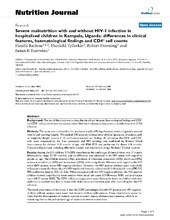| dc.contributor.author | Bachou, Hanifa | en_US |
| dc.contributor.author | Tylleskär, Thorkild | en_US |
| dc.contributor.author | Downing, Robert | en_US |
| dc.contributor.author | Tumwine, James K. | en_US |
| dc.date.accessioned | 2006-10-23T13:15:33Z | |
| dc.date.available | 2006-10-23T13:15:33Z | |
| dc.date.issued | 2006-10-16 | eng |
| dc.identifier.issn | 1475-2891 | |
| dc.identifier.uri | https://hdl.handle.net/1956/1908 | |
| dc.description.abstract | Background: The aim of this study was to describe the clinical features, haematological findings and CD4+ and CD8+ cell counts of severely malnourished children in relation to human immunodeficiency virus (HIV) infection. Methods: The study was conducted in the paediatric wards of Mulago hospital, which is Uganda’s national referral and teaching hospital. We studied 315 severely malnourished children (presence of oedema and/or weightfor- height: z-score < –3) and have presented our findings. At admission, the CD4+ and CD8+ cells were measured by the flow cytometry and HIV serology was confirmed by Enzyme linked Immunoassay for children >18 months of age, and RNA PCR was performed for those ≤18 months. Complete blood count, including differential counts, was determined using a Beckman Coulter counter. Results: Among the 315 children, 119 (38%) were female; the median age of these children was 17 months (Interquartile range 12–24 months), and no difference was observed in the HIV status with regard to gender or age. The children showed a high prevalence of infections: pneumonia (68%), diarrhoea (38%), urinary tract infection (26%) and bacteraemia (18%), with no significant difference with regard to the HIV status (HIV-positive versus HIV-negative children). However, the HIV-positive children were more likely to have persistent diarrhoea than the HIV-uninfected severely malnourished children (odds ratio (OR) 2.0, 95% confidence interval (CI) 1.2–3.6). When compared with the HIVnegative children, the HIV-positive children showed a significantly lower median white blood cell count (10700 versus 8700) and lymphocyte count (4033 versus 2687). The CD4+ cell percentages were more likely to be lower in children with non-oedematous malnutrition than in those with oedematous malnutrition even after controlling for the HIV infection. The novel observation of this study is that the CD4+ percentages in both HIV-positive and HIV-negative children without oedema were lower that those in children with oedema. These observations appear to imply that the development of oedema requires a certain degree of immunocompetence, which is an interesting clue to the pathophysiology of oedema in severe malnutrition. | en_US |
| dc.format.extent | 257916 bytes | eng |
| dc.format.mimetype | application/pdf | eng |
| dc.language.iso | eng | eng |
| dc.publisher | BioMed Central | eng |
| dc.rights | Attribution CC BY | eng |
| dc.rights.uri | http://creativecommons.org/licenses/by/2.0 | eng |
| dc.title | Severe malnutrition with and without HIV-1 infection in hospitalised children in Kampala, Uganda: differences in clinical features, haematological findings and CD4+ cell count | en_US |
| dc.type | Peer reviewed | |
| dc.type | Journal article | |
| dc.description.version | publishedVersion | en_US |
| dc.rights.holder | Copyright 2006 Bachou et al; licensee BioMed Central Ltd. | |
| dc.identifier.doi | https://doi.org/10.1186/1475-2891-5-27 | |
| dc.identifier.cristin | 377683 | |
| dc.source.journal | Nutrition Journal | |
| dc.source.40 | 5 | |
| dc.source.14 | 27 | |
| dc.subject.nsi | VDP::Medisinske Fag: 700::Helsefag: 800 | nob |
| dc.subject.nsi | VDP::Medisinske Fag: 700::Helsefag: 800::Ernæring: 811 | nob |

